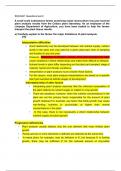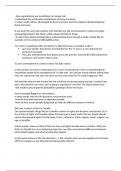SSCA041 Questions test 2
A small scale subsistence farmer practicing maize monoculture has just received
plant analysis results from the Cedara plant laboratory. As an employee of the
Limpopo Department of Agriculture, you have been tasked to help the farmer
interpret the plant tissue results.
a) Carefully explain to the farmer the major limitations of plant analysis.
[15]
Interpretation difficulties
• Good relationship can be developed between soil nutrient supply, nutrient
levels in the plant and crop yield for a given plant part, time of sampling
and location in any one year.
• However, differences in location, varities, time and management often
cause variations in these relationships and make them difficult to interpret.
• Nutrient levels in plant differ depending on the plant part sampled, stage of
maturity, hybrid and climatic conditions.
• Interpretation of plant analysis must consider these factors.
• For this reason, most plant analysis interpretations are based on a specific
plant part sampled at definite stages of development.
Interrelationship of other factors
• Interpreting plant analysis assumes that the chemical composition of
the plant reflects its nutrient supply in relation to crop growth.
• There are situations, however, when the nutrient concentrations in the
plant are not the primary factor responsible for the amount of plant
growth obtained For example, any factor that limits growth may cause
non-limiting nutrients to accumulate at higher than normal
concentrations in the plant
• In this case, there is not necessarily a direct relationship between
nutrient supply and plant growth.
Progressive deficiencies
• Plant analysis usually detects only the one element that most inhibits plant
growth
• Rarely are two or more elements in deficient are detected at the same time
• A maize plant, for example, may be deficient in K, but because K is limiting
growth, there may be sufficient P for the reduced amount of dry-matter
, production even if the soil P supply is low
• However, when K is added as a remedial treatment, dry-matter production
increases sharply; then P becomes deficient
• Nitrogen stress, on the other hand, can limit the uptake of phosphorus and some
of the micronutrients to the extent that they appear to be “low”
Secondary deficiencies
• If plant growth is limited because of something other than a nutrient shortage
(i.e., insect feeding or lack of water)
• – the nutrient deficiency symptoms expressed may be a secondary effect
• Adding more nutrient in this case will not increase nutrient uptake or plant
growth.
Sample contamination and deterioration
• Contamination of a plant sample with soil particles or pesticide residue can lead
to erroneously high results for iron, aluminium, manganese, zinc, or copper
• Washing the sample to remove contamination can introduce other contaminants
if a detergent or tap water are used – Appreciable potassium can be lost by
washing
• Decomposition of a plant sample before it reaches the laboratory will result in a
– loss of carbon (as CO2 through respiration and microbial activity) – the
concomitant increased concentration of most other elements, thereby giving
erroneously
• This can be prevented by refrigerating the sample until it is delivered to the
laboratory or air drying to 15 or 25% moisture
b) Provide a synthesis on why plant tissue analysis need to be integrated with
soil analysis to effectively guide the application of nutrients as well as diagnose
problems as they arise in the maize field. [10]
•
Sometimes adequate nutrient level may be present in the soil. But with
because of other problems such as cool temperatures at planting, insect
feeding or root damage, inadequate amount of nutrient get into the plant.
Plant analysis along with soil test can help pinpoint the problem e.g. plant
analysis of maize ear leaf samples may show high level of manganese
present. But the soil analysis identifies the actual problem is very acidic
soil resulting in excessive manganese availability.
A small scale subsistence farmer practicing maize monoculture has just received
plant analysis results from the Cedara plant laboratory. As an employee of the
Limpopo Department of Agriculture, you have been tasked to help the farmer
interpret the plant tissue results.
a) Carefully explain to the farmer the major limitations of plant analysis.
[15]
Interpretation difficulties
• Good relationship can be developed between soil nutrient supply, nutrient
levels in the plant and crop yield for a given plant part, time of sampling
and location in any one year.
• However, differences in location, varities, time and management often
cause variations in these relationships and make them difficult to interpret.
• Nutrient levels in plant differ depending on the plant part sampled, stage of
maturity, hybrid and climatic conditions.
• Interpretation of plant analysis must consider these factors.
• For this reason, most plant analysis interpretations are based on a specific
plant part sampled at definite stages of development.
Interrelationship of other factors
• Interpreting plant analysis assumes that the chemical composition of
the plant reflects its nutrient supply in relation to crop growth.
• There are situations, however, when the nutrient concentrations in the
plant are not the primary factor responsible for the amount of plant
growth obtained For example, any factor that limits growth may cause
non-limiting nutrients to accumulate at higher than normal
concentrations in the plant
• In this case, there is not necessarily a direct relationship between
nutrient supply and plant growth.
Progressive deficiencies
• Plant analysis usually detects only the one element that most inhibits plant
growth
• Rarely are two or more elements in deficient are detected at the same time
• A maize plant, for example, may be deficient in K, but because K is limiting
growth, there may be sufficient P for the reduced amount of dry-matter
, production even if the soil P supply is low
• However, when K is added as a remedial treatment, dry-matter production
increases sharply; then P becomes deficient
• Nitrogen stress, on the other hand, can limit the uptake of phosphorus and some
of the micronutrients to the extent that they appear to be “low”
Secondary deficiencies
• If plant growth is limited because of something other than a nutrient shortage
(i.e., insect feeding or lack of water)
• – the nutrient deficiency symptoms expressed may be a secondary effect
• Adding more nutrient in this case will not increase nutrient uptake or plant
growth.
Sample contamination and deterioration
• Contamination of a plant sample with soil particles or pesticide residue can lead
to erroneously high results for iron, aluminium, manganese, zinc, or copper
• Washing the sample to remove contamination can introduce other contaminants
if a detergent or tap water are used – Appreciable potassium can be lost by
washing
• Decomposition of a plant sample before it reaches the laboratory will result in a
– loss of carbon (as CO2 through respiration and microbial activity) – the
concomitant increased concentration of most other elements, thereby giving
erroneously
• This can be prevented by refrigerating the sample until it is delivered to the
laboratory or air drying to 15 or 25% moisture
b) Provide a synthesis on why plant tissue analysis need to be integrated with
soil analysis to effectively guide the application of nutrients as well as diagnose
problems as they arise in the maize field. [10]
•
Sometimes adequate nutrient level may be present in the soil. But with
because of other problems such as cool temperatures at planting, insect
feeding or root damage, inadequate amount of nutrient get into the plant.
Plant analysis along with soil test can help pinpoint the problem e.g. plant
analysis of maize ear leaf samples may show high level of manganese
present. But the soil analysis identifies the actual problem is very acidic
soil resulting in excessive manganese availability.




